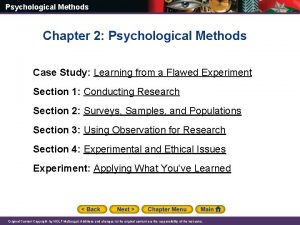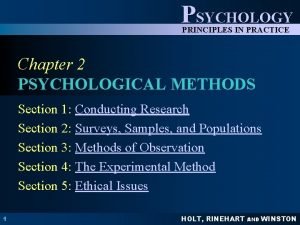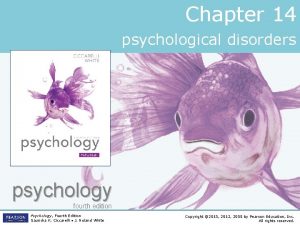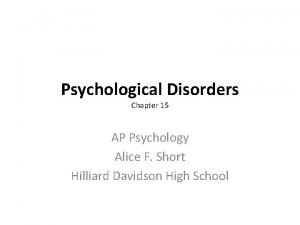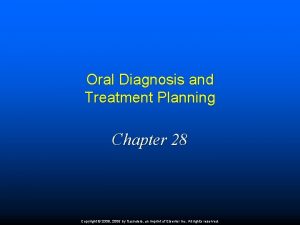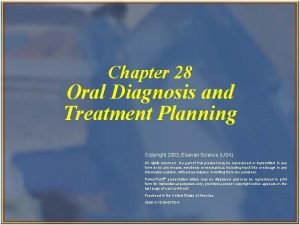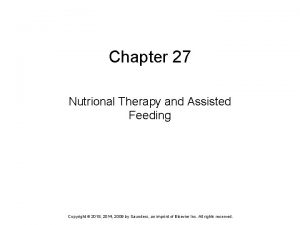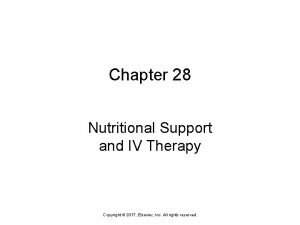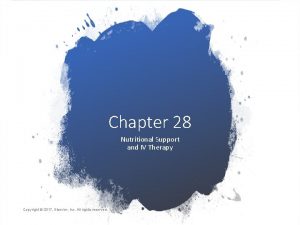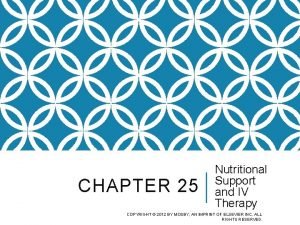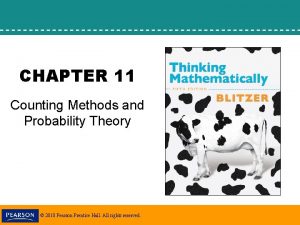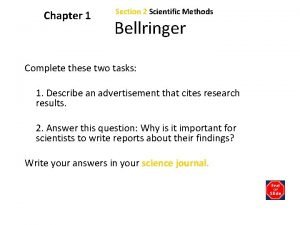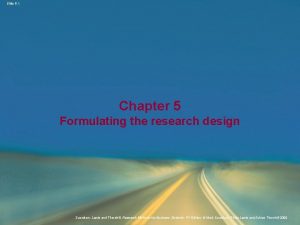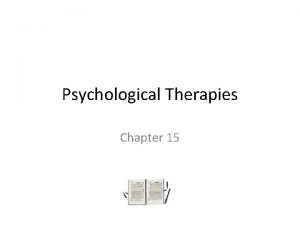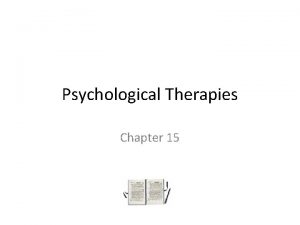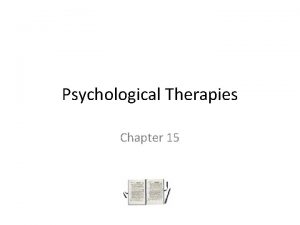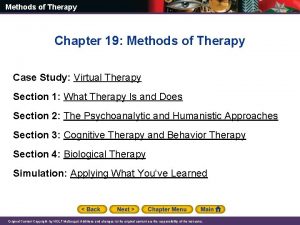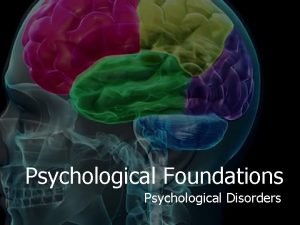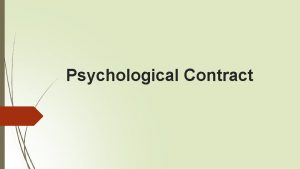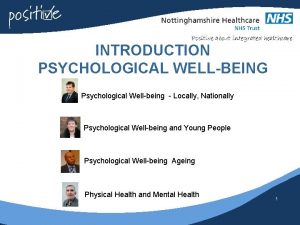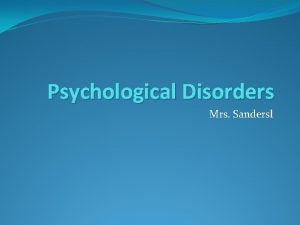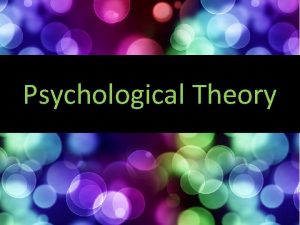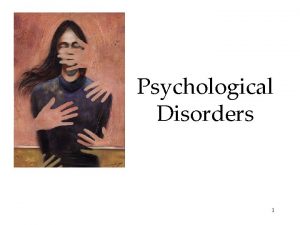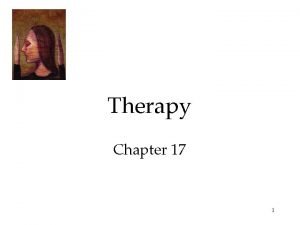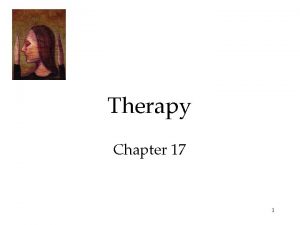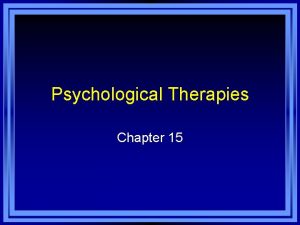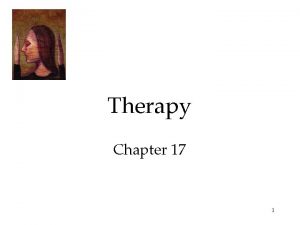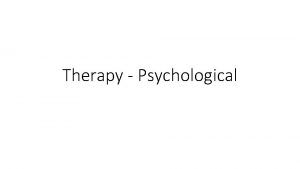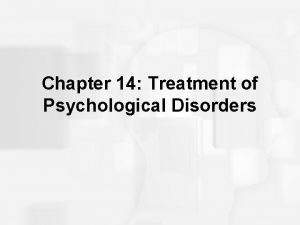METHODS OF THERAPY CHAPTER 17 Treatment of Psychological























- Slides: 23

METHODS OF THERAPY CHAPTER 17

Treatment of Psychological Disorders 2 main categories of mental health treatment: § Psychotherapy – for learning-related disorders such as phobias. § Re-learn how to alleviate learned problems § Biomedical Therapy – for biologically influenced disorders such as schizophrenia. § Medication or medical procedure

Treatment of Psychological Disorders § May choose to use a biopsychosocial approach and draw from a variety of techniques. § Eclectic Approach – an approach to psychotherapy which is a blend of approaches, depending on the problem of the client

Psychotherapy § Psychotherapy – Treatment involving psychological techniques; consists of interactions between a trained therapist and someone seeking to overcome a psychological difficulty or achieve personal growth. § Includes psychoanalytic, humanistic, behavioral, and cognitive therapies – used 1 on 1 or in groups of people

Psychoanalysis § Sigmund Freud – 1 st of the psychological therapies § Freud believed the patient’s free associations, resistances, dreams, and transferences – and therapist’s interpretations of them – released previously repressed feelings, allowing the patient to gain self-insight. § Attributes our thoughts and actions to unconscious motives and conflicts § Presumes that healthier, less anxious living is possible when energy previously devoted to id-ego-superego conflicts is released.

Psychoanalytical Techniques § Free Association - involves the client speaking freely about any topic or image that comes into his her mind § Resistance - when the client unconsciously tires to block the process of revealing repressed memories - this leads to revealing conflicts § Interpretation - during free association therapist offers insight to and explanations of the client’s thoughts, remarks and actions

Psychoanalytical Techniques § Dream interpretation - involves identifying and separating the manifest content (portion of the dream that is consciously remembered), and the latent content (the impulses, wishes, and fantasies) which help to gain insight into the unconscious § Transference - occurs when the patient unconsciously transfers emotions linked with other relationships to the analyst - most important technique

Contemporary Psychodynamic Therapy § Criticisms – expensive, time-consuming, interpretations can’t be proven or disproven § Short-term psychodynamic therapy - more common now § clients get quicker diagnosis and are not required to go for more than a few months – (emphasis still on the unconscious) § Interpersonal therapy - another psychodynamic approach § focuses on current relationships instead of spending too much time on the past

Humanistic Therapy § Belief that people are inherently good and are motivated to grow psychologically § Emphasizes striving for and reaching human potential § Believe a person’s self-concept (thoughts of themselves) is the most important feature, and given the right environment, the self-concept can grow

Humanistic Therapy § Differ from the psychoanalytic perspective in 3 ways: • Focus on fostering growth instead of relieving illness • Focus on the present and future instead of the past • Emphasize conscious thought as opposed to the unconscious § Carl Rogers, once a psychodynamic therapist, was upset with how formal and detached psychoanalysis had become and as a result became a humanistic therapist. • Wanted to establish a therapeutic environment that encouraged growth and self-discovery by the client

Humanistic Therapy Assumptions: § Treatment is an encounter between equals (not “cure” by “expert”) § Clients improve on their own, given the right conditions (conditions promote awareness, acceptance, emotional expression) § Ideal conditions established by feeling fully accepted/supported as human beings § Clients remain responsible for choosing how they think/behave

Humanistic Therapy Client-centered or person-centered therapy: § Allows client to decide what to talk about without direction (non-directive therapy), judgment, or interpretation § Rogers encouraged therapists to exhibit a genuine, accepting, empathic environment to facilitate the client’s growth § Active listening – Empathic listening in which the listener echoes, restates, and clarifies what the person expresses

Behavior Therapy § Psychodynamic therapy – people fix problems by gaining insight into their unconscious minds § Humanistic therapy – people fix problems as they get in touch with their feelings § Behavior therapy – § Doubts healing power of self-awareness § Assumes behaviors are the problems § Applies learning principles to eliminate an unwanted behavior (classical & operant conditioning) § Learned behaviors (phobias or anxiety) are replaced by constructive behaviors

Behavior Therapy Counterconditioning – learning of a new conditioned response that is more effective than the original learned response • Two types – exposure therapies & aversive conditioning: § Exposure Therapy – treat anxieties by exposing people to the things they fear and avoid (Mary Cover Jones - Peter & the rabbit) § Aversive Conditioning – associates an unpleasant state with an unwanted behavior

Behavior Therapy Types of exposure therapy: § Systematic Desensitization – type of counterconditioning that associates a pleasantly relaxed state with gradually increasing anxiety-triggering stimuli (Commonly used to treat phobias) § Virtual reality exposure therapy – allows clients to experience their fears in a controlled computerized setting without real -world context

Behavior Therapy § Aversive conditioning – seeks to condition an aversion to something the client should avoid (the reverse of systematic desensitization) § Associates the unwanted behavior with unpleasant feelings (ex. Alcoholism) § Criticisms of aversive conditioning: § May only work short-term § Cognition influences conditioning – people can discriminate between the aversive situation and all other situations

Behavior Therapy § Behavior modification therapists believe that maladaptive behavior can also be modified through consequential actions § Operant Conditioning – used to reinforce desired behaviors and to withhold reinforcement for undesired behaviors § Positive reinforcements - Set up contingencies (rules) that specify behaviors to be strengthened through reinforcement of closer and closer approximations

Behavior Therapy § Token economies - a token (positive reinforcement) is given after a desired behavior is performed (often used in rehab or institutional setting) § Can be exchanged for desired items/activities § Used by parents, schools, daycares, hospitals

Cognitive Therapy § Aaron T. Beck, originally trained as a psychoanalyst, developed cognitive therapy (CT) § Cognitive therapy - Teaches people new, more adaptive ways of thinking and acting § Based on the assumptions that our thoughts intervene between events and our emotional reactions § Seeks to reverse people’s negative about themselves, their situations, and their futures

Cognitive Therapies § Cognitive-Behavioral Therapy – therapy that combines cognitive (self-defeating thinking) and behavior (changing behavior) therapies. § Attempts to alter thoughts as well as the actions § Especially effective in treating OCD, anxiety, or depression

Group and Family Therapies Advantages of group therapy: § Saves time & money § Learn other’s have the same problems too § Receive feedback as they try out new ways of behaving § Group therapy works well with alcoholics (AA) Family Therapy – view’s an individual’s behavior as guided by or directed at other family members § tries to improve communication and relationships in this “system”


Evaluating Psychotherapeutic Approaches A meta-analysis gathers large amounts of data from a variety of sources and then presents the data in a single report § Cognitive, behavior, and interpersonal therapies effective for treating depression § Cognitive, behavior, and exposure therapies good for treating phobias, panic disorders, and OCD § Cognitive-behavior therapy good for treating disorders § Behavior modification good for treating bed-wetting § Psychoanalysis good for treating borderline personality disorder, and substance abuse disorders
 Single blind study
Single blind study Psychology chapter 2 section 1
Psychology chapter 2 section 1 Chapter 19 methods of therapy
Chapter 19 methods of therapy Glasser modeli
Glasser modeli Psychoanalytic therapy is to as humanistic therapy is to
Psychoanalytic therapy is to as humanistic therapy is to Bioness integrated therapy system price
Bioness integrated therapy system price What are the major humanistic therapies
What are the major humanistic therapies Wax pattern in fpd
Wax pattern in fpd Chapter 18 psychological disorders
Chapter 18 psychological disorders Chapter 18 psychological disorders
Chapter 18 psychological disorders Chapter 14 psychological disorders
Chapter 14 psychological disorders Chapter 14 psychological disorders
Chapter 14 psychological disorders Ap psychology chapter 15 psychological disorders
Ap psychology chapter 15 psychological disorders Charting exercise chapter 28
Charting exercise chapter 28 Oral diagnosis and treatment planning ppt
Oral diagnosis and treatment planning ppt Chapter 1 risk and its treatment
Chapter 1 risk and its treatment Chapter 27 nutritional therapy and assisted feeding
Chapter 27 nutritional therapy and assisted feeding Chapter 28 nutritional support and iv therapy
Chapter 28 nutritional support and iv therapy Chapter 28 nutritional support and iv therapy
Chapter 28 nutritional support and iv therapy Chapter 28 nutritional support and iv therapy
Chapter 28 nutritional support and iv therapy Chapter 11 counting methods and probability theory answers
Chapter 11 counting methods and probability theory answers Scientific method bellringer
Scientific method bellringer Research methods for business students chapter 5
Research methods for business students chapter 5 Dehn psw model
Dehn psw model
